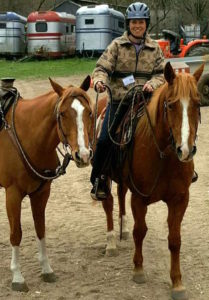
Amy Skinner
Editor’s Note: Amy Skinner is a regular guest columnist and has been a horse gal since age six. She works with owner/operator Jim Thomas as a trainer at Bar T Horsemanship where she rides and teaches English and Western. She has studied at the Royal Andalusian School of Equestrian Art in Spain, with Buck Brannaman, Leslie Desmond, Brent Graef, and many others. Skinner sits on the Best Horse Practices Summit steering committee.
This is Part II of a two-part piece on identifying roadblocks to lightness.
By Amy Skinner
Here are additional areas that I’ve found can inhibit lightness with our horses:
Tacking up, mounting, and warming up:
As you go through your habitual grooming, tacking up, and warming up routine, take notice:
Do you do the same things in the same order each time?
 Many of my students haven’t even noticed that they have a routine they follow until I bring it to their attention.
Many of my students haven’t even noticed that they have a routine they follow until I bring it to their attention.
They always:
- Start on the same side
- Get on in the same place
- Warm up to the left first, and so on.
If we are mindlessly going through the motions, it’s easy to be unaware of little slips here and there on our horse’s part.
Maybe they inched around while we saddled, or walked a few steps while we mounted.
Because we aren’t organized or in the moment, we cannot correct or head off these mistakes. Therefore, the horse gets into bad habits because of our bad habit of mindlessness.
I want my horse to be aware and responding to me as I go through getting him ready to ride. I watch him carefully and ask him to watch me carefully. I mount on both sides regularly, warm up in different ways and different places. I work toward the goal of having a responsive horse. A responsive horse is only possible when we ourselves are aware and attentive enough to notice when our horses are checked out.
 Bit fit:
Bit fit:
Is your bit hiked up to two or three wrinkles in your horses lip?
If your horse is smiling like the joker while your reins are completely loose, imagine the amount of pressure he feels in his mouth when there is no message being relayed to him. It’s constant pressure with no meaning.
Later, when you need your rein to mean something, imagine how much more pressure you will need to apply in order to get his attention. If the bit is kept lower, to where the horse has no wrinkles (but not so low that it bangs his teeth), he can hold it up himself without pressure. When your rein needs to have meaning, he can feel a much quieter message in the corner of his lip.
Think of people you know who talk loudly and incessantly – for them to really make a point, they have to shout. Prospective listeners are so desensitized to the volume and frequency of their speaking, that these shouters’ words don’t carry much meaning. On the other hand, people tend to lean in and listen when someone speaks softly, meaningfully, and infrequently. This is how we want our hands to be to our horse.

Photo by Julie Kenney
Position mistakes:
Are your legs constantly flapping against the horse’s sides
Are your hands coming back as you post?
Are your hips and legs tight, preventing your horse from getting loose?
Rider mistakes can create dullness as the horse sorts through which messages have meaning and which ones don’t. Often students with “lazy” horses who won’t go forward really just have horses who have learned to ignore leg aids because they never end and rarely have meaning.
This might be more challenging than some of the other roadblocks to lightness. I suggest trying to find a reliable instructor who focuses on discovering and developing softness in your horse and who will help you develop a better seat for a lighter, softer horse.
Final thoughts:
Training might take up an hour a day. Most of us don’t even ride that much. Therefore, what makes up the rest of the horses’ day really matters.
How we handle them matters.
How they interact with their world at large matters.
How they perceive their role in our world matters.
Imagine the confusion horses feel as they live one way for 23 hours, and for the 24th hour they’re expected to suddenly adjust. A horse who understands what’s expected of him can be a relaxed and happy horse, if his human is willing to be disciplined and attentive in his day-to-day interactions with him.
Thanks Amy, for another thoughtful article to help us all be more mindful when we handle or ride our horses